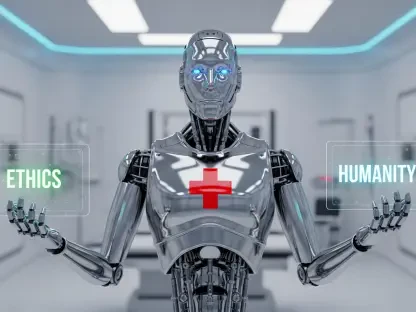Setting the Stage for Digital Healthcare Transformation
Imagine a hospital where patient data flows seamlessly between departments, clinicians make decisions based on real-time insights, and operational inefficiencies are a thing of the past. This vision, while aspirational, is increasingly within reach thanks to advancements in health IT infrastructure. The healthcare sector stands at a pivotal moment, where technology is not just a tool but a cornerstone of delivering high-quality, cost-effective care. With rising demands for accountability and value-based outcomes, health IT systems are under intense scrutiny to prove their worth. This review dives deep into the components, capabilities, and challenges of health IT infrastructure, shedding light on how it shapes modern healthcare delivery.
Foundations of Health IT Infrastructure
Health IT infrastructure has evolved dramatically from rudimentary electronic records to complex, interconnected systems that underpin healthcare operations. Initially focused on digitizing patient information, these systems now integrate diverse technologies to support clinical workflows, data sharing, and decision-making. The journey reflects a broader digital transformation in healthcare, where the goal is no longer just automation but creating a cohesive ecosystem that enhances every facet of care delivery.
At the heart of this infrastructure lie foundational elements such as electronic health records (EHRs), interoperability standards, and data management platforms. These components work together to ensure that healthcare providers can access accurate, timely information, regardless of location or system. The push toward digital maturity has been driven by the need to address inefficiencies, reduce errors, and meet regulatory expectations, positioning health IT as a critical enabler of systemic change.
This evolution also mirrors the growing complexity of healthcare challenges, from managing chronic diseases to responding to public health crises. As organizations strive to balance clinical excellence with financial sustainability, health IT infrastructure serves as the backbone that aligns technology with strategic goals. Understanding these foundations provides a lens to appreciate the sophisticated capabilities that define today’s systems.
Core Components and Capabilities
Electronic Health Records (EHRs) and Interoperability
EHRs stand as the central pillar of health IT infrastructure, offering a digital repository for patient data that transcends traditional paper records. These systems enable healthcare providers to store, retrieve, and share critical information such as medical histories, treatment plans, and test results. Beyond mere storage, EHRs facilitate care coordination by ensuring that multiple providers can access a unified patient profile, reducing the risk of fragmented care.
Interoperability, however, remains a significant hurdle in maximizing the potential of EHRs. Despite advancements, many systems still struggle to communicate effectively across different platforms and organizations. This lack of seamless data exchange can lead to delays, errors, and missed opportunities for timely intervention, underscoring the need for standardized protocols and robust integration frameworks to bridge these gaps.
The impact of achieving true interoperability cannot be overstated, as it directly influences patient safety and treatment efficacy. Efforts to standardize data formats and enhance system compatibility are gaining traction, driven by regulatory mandates and industry collaboration. As these barriers diminish, EHRs are poised to become even more powerful tools in transforming healthcare delivery.
Data Analytics and Decision Support Tools
Data analytics platforms within health IT infrastructure empower organizations to extract actionable insights from vast amounts of clinical and operational data. By leveraging sophisticated algorithms, these tools identify patterns, predict outcomes, and highlight areas for improvement, such as reducing hospital readmissions or optimizing resource allocation. This capability shifts healthcare from a reactive to a proactive model, where decisions are grounded in evidence.
Clinical decision support tools complement analytics by providing real-time guidance to providers at the point of care. These systems integrate patient data with medical knowledge to offer recommendations, flag potential issues like drug interactions, and ensure adherence to best practices. Such support not only enhances the quality of care but also alleviates the cognitive burden on clinicians, allowing them to focus on patient interaction.
The synergy between analytics and decision support is reshaping cost management as well. By identifying inefficiencies and forecasting trends, these tools help organizations allocate resources more effectively, ultimately driving down expenses without compromising outcomes. As technology advances, the precision and scope of these insights continue to expand, promising even greater impact on healthcare systems.
Emerging Trends in Health IT
The landscape of health IT infrastructure is being reshaped by cutting-edge innovations that promise to redefine care delivery. Cloud computing, for instance, offers scalable, secure environments for storing and processing data, enabling organizations to adapt quickly to changing demands. This shift reduces the burden of maintaining on-site servers while enhancing accessibility for remote and hybrid care models.
Artificial intelligence (AI) is another transformative force, with applications ranging from predictive diagnostics to personalized treatment plans. AI algorithms can analyze complex datasets faster than human counterparts, uncovering insights that improve clinical precision. Meanwhile, telehealth integration has surged, embedding virtual care into the broader IT ecosystem to ensure patients receive timely consultations regardless of geographic barriers.
Legislative pressures, such as mandates tied to value-based care, are also influencing trends, with policies emphasizing accountability in IT spending. Industry expectations are evolving toward measurable outcomes, pushing vendors and providers to demonstrate tangible benefits. These dynamics signal a future where health IT must continuously innovate to meet both technological and regulatory demands.
Real-World Applications and Impact
Health IT infrastructure is proving its value across diverse healthcare settings, from bustling urban hospitals to rural clinics. In large medical centers, integrated systems have streamlined patient triage and reduced wait times by automating administrative tasks and prioritizing urgent cases. Such implementations highlight how technology can directly enhance operational efficiency and patient satisfaction.
Public health initiatives also benefit significantly, as seen in disaster response systems that leverage health IT to coordinate resources during emergencies. These platforms enable rapid data sharing among agencies, ensuring that critical information reaches first responders in real time. Similarly, population health management programs use aggregated data to track disease trends and target interventions, improving community-wide outcomes.
Unique case studies further illustrate the versatility of health IT, such as mobile clinics equipped with portable EHRs to serve underserved areas. These applications not only bridge access gaps but also generate valuable data for long-term planning. The measurable improvements in care quality and cost savings from these deployments underscore the practical power of a well-designed IT framework.
Challenges and Limitations in Health IT
Despite its potential, health IT infrastructure faces substantial obstacles that hinder widespread success. User adoption remains a persistent issue, as clinicians and staff often resist systems that feel cumbersome or disrupt established workflows. Insufficient training and lack of input during design phases exacerbate this resistance, leading to underutilization and diminished returns on investment.
Cybersecurity risks pose another critical challenge, with healthcare data being a prime target for breaches due to its sensitive nature. Compliance with regulations like HIPAA is non-negotiable, yet fragmented systems and inadequate safeguards increase vulnerability. The financial and reputational consequences of data leaks demand urgent attention to robust security protocols and governance structures.
Financial constraints add to the complexity, as many organizations struggle to fund comprehensive IT upgrades amidst tight budgets. Balancing cost with the need for cutting-edge solutions requires innovative funding models and strategic prioritization. Addressing these limitations through better design, training, and policy support is essential to unlocking the full potential of health IT.
Future Outlook for Health IT Infrastructure
Looking ahead, health IT infrastructure is set to evolve in ways that could fundamentally alter healthcare delivery. Innovations like AI-driven personalized medicine hold the promise of tailoring treatments to individual genetic profiles, improving efficacy and reducing side effects. Such advancements signal a shift toward precision care that prioritizes patient-specific needs.
Greater patient engagement through mobile health platforms is also on the horizon, empowering individuals to manage their health with real-time access to data and virtual support. These tools foster a collaborative care model, where patients and providers work together more effectively. The integration of wearable devices further enhances this trend, providing continuous monitoring for proactive interventions.
The long-term vision includes a fully integrated, secure IT ecosystem that prioritizes outcomes over mere implementation. Societal benefits, such as reduced healthcare disparities and improved public health resilience, are achievable if interoperability and security challenges are addressed. This trajectory suggests a future where technology and care are seamlessly aligned for maximum impact.
Final Reflections and Next Steps
Reflecting on the exploration of health IT infrastructure, it is clear that its transformative potential has already begun to reshape healthcare delivery in profound ways. The detailed analysis of components like EHRs and data analytics reveals a robust foundation that, despite challenges, delivers measurable improvements in clinical and operational outcomes.
Moving forward, stakeholders need to prioritize strategic investments that align with value-based care goals, focusing on user-centric design to boost adoption among frontline staff. Strengthening cybersecurity measures and fostering interoperability stand out as critical steps to safeguard data and ensure system-wide efficiency.
Additionally, leveraging emerging technologies such as AI and mobile health platforms offers a pathway to personalize care and engage patients more deeply. By committing to disciplined governance and continuous innovation, healthcare organizations can turn health IT into a true driver of sustainable, high-quality care, setting a new standard for the industry.









